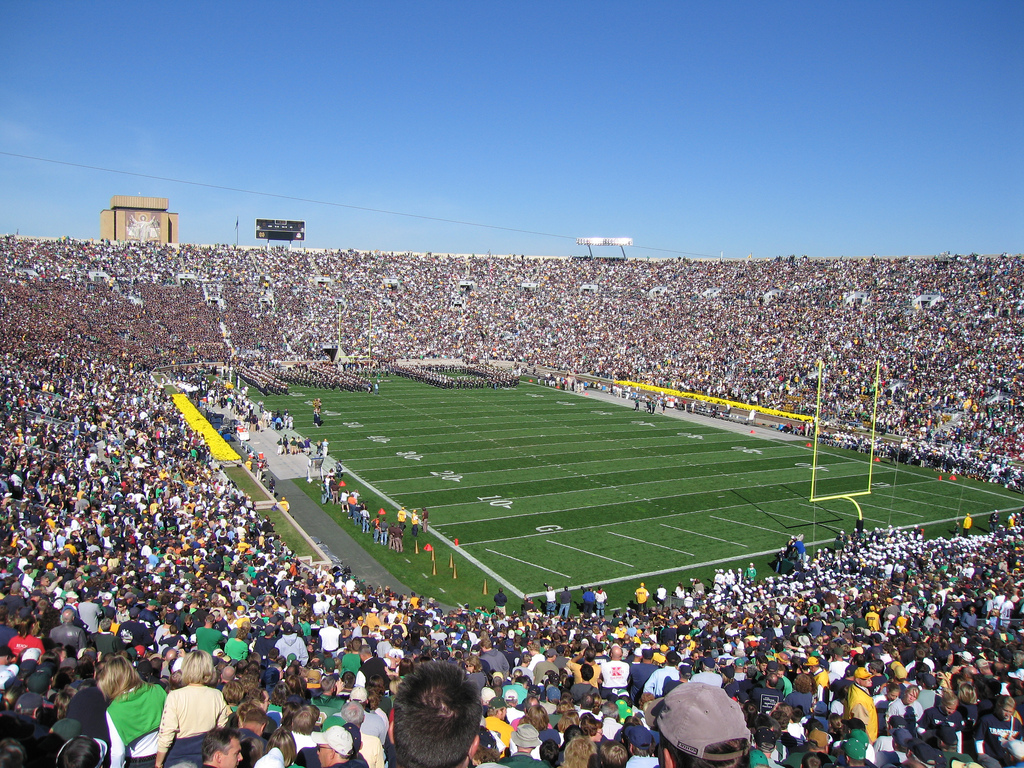Notre Dame Fighting Irish football is a program full of success and legacy with 11 national titles and seven Heisman Trophy winners plays at a stadium, Notre Dame Stadium, that is full of history and tradition. The long and storied history of Fighting Irish football at Notre Dame Stadium dates back to October 4, 1930 when the team battled SMU during the first game at the facility.
Notre Dame Stadium was built to replace Cartier Field, a 30,000 seat facility that opened in 1889. A new stadium was deemed necessary with the success of the team leading to sold out games at Cartier Field. Coach Knute Rockne was instrumental in getting a new stadium constructed. Osborn Engineering led the design of the $750,000 stadium, patterned after Michigan Stadium, and in late 1929 construction began. Original capacity was 54,000 as the one tier grandstand enclosed the field. Throughout its over eight decade existence, Notre Dame Stadium has only had one main addition. Prior to the 1997 season, the stadium was expanded to seat 80,795 fans. Nearly 21,000 seats were added along the top rim of the stadium. In addition, the first three rows of seats were eliminated, a new grass field was installed, new scoreboards were placed above the rim of the stadium in the north and south end zones and a new three tier press box was built. The grass field was replaced with Fieldturf in 2014.
In January 2014 Notre Dame unveiled plans for its $400 million Campus Crossroads Project at Notre Dame Stadium. This project included the addition of of three nine-story buildings on the east, south and west sides that directly ties into the stadium. Totaling 750,000 square feet, these buildings include club levels, indoor and outdoor club seats and space that serves nonathletic purposes including classrooms, a music library and media center. A new 96 x 54 foot HD videoboard was added in the south endzone. The scoreboard in the north endzone was removed, giving fans a better view of the “Touchdown Jesus” mural. All of the bleachers were removed and replaced with new vinyl-clad blue benches. The width of each seat was widened by two inches, decreasing the overall capacity of Notre Dame Stadium to 80,795. Additional upgrades were completed around the stadium including upgrading the sound system, concourses, restrooms and concession areas. The entire project at Notre Dame Stadium was completed by the 2017 season.
Notre Dame Stadium remains one of the most unique stadiums in college football with its brick exterior and location on the Notre Dame campus in South Bend, IN. Located above the north endzone is one of the most iconic features in college football, a piece of art nicknamed, “Touchdown Jesus.” Located on the Hesburgh Library, this 134 foot tall The World of Life mural looms over the endzone at Notre Dame Stadium. A trip to this historic and iconic stadium is a must for any college football fan. The stadium hosted its first hockey game in 2019 as the NHL Winter Classic between the Chicago Blackhawks at Boston Bruins was played at Notre Dame Stadium on January 1, 2019.

